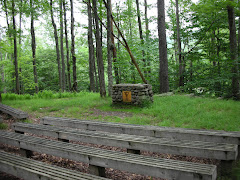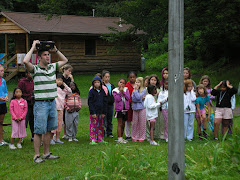- - -
Before Summer Camps Throw Open Doors, Girding for Swine Flu
CLARYVILLE, N.Y. — At the Frost Valley Y.M.C.A. camp last week, counselors and staff were laying out swim lines, whitewashing a fence around the horse paddock and mowing the meadow in the shadow of Wild Cat Mountain.
But there were a few more things on the checklist before this year’s campers arrived.
Housekeepers were wiping down doorknobs with bleach solution. The medical staff was adding new questions about fevers and coughs to the opening-day health screenings, which traditionally target head lice. Three negative-pressure isolation rooms were ready to accommodate sick campers. Hand sanitizer was everywhere.
Here and across the country, summer camps have been busy trying to erect a firewall against swine flu.
“We think we’re ahead of the curve, but who knows?” said Jerry Huncosky, chief executive officer of Frost Valley, a 6,000-acre camp in the Catskill Mountains. “I think it’s the ‘who knows?’ that we’re preparing for.”
Sleep-away camp, of course, is a time of rustic simplicity and extremely close contact: 8 to 10 campers in a snug cabin is the norm. With swine flu’s potential for rapid transmission, camp poses unusual challenges for the adults charged with the campers’ care. It is perhaps no wonder that camp directors have been deluged in recent weeks with e-mail messages about swine flu protocols from the Centers for Disease Control and Prevention, the American Camp Association and local health departments.
Swine flu has already surfaced at summer camps in the South and the West, where the camp season begins early, closing camps in Missouri and California and prompting the Muscular Dystrophy Association to cancel the rest of its annual summer camp program.
Outbreaks of swine flu have also been reported at camps in Georgia and North Carolina, but campers there were being treated on site.
 The first task is simply to keep out the H1N1 virus, as swine flu is formally known. Like many camps, Frost Valley recently sent a letter to parents telling them not to send their children to camp if they have flulike symptoms: “fever over 100 degrees and cough, sore throat, runny nose or stuffy nose.” The letter added, “If you suspect your child is getting the flu, it is important that he or she does not attend camp or go anywhere else.”
The first task is simply to keep out the H1N1 virus, as swine flu is formally known. Like many camps, Frost Valley recently sent a letter to parents telling them not to send their children to camp if they have flulike symptoms: “fever over 100 degrees and cough, sore throat, runny nose or stuffy nose.” The letter added, “If you suspect your child is getting the flu, it is important that he or she does not attend camp or go anywhere else.”Mr. Huncosky acknowledged that the rule could challenge some parents, especially those whose own vacations coincide with their children’s camp sessions. “It’s hard when you spend a lot of money to send your child to camp and then the Friday before, they have a little fever,” he said. “Parents might say, ‘We’ve got too much invested.’ ”
Of the 500 campers who arrived on Sunday at Frost Valley, two were found to have a fever as well as other flu symptoms and were sent home.
Frost Valley and other camps said they would try to work with families, either allowing a child to make up lost time in a later session or prorating the fees.
At Buck’s Rock Performing and Creative Arts Camp in New Milford, Conn., opening day was on Wednesday, and the medical staff members took the temperatures of all 260 arriving campers.
There was one case of nits (lice eggs), but no fever, said Mickey Morris, who directs the camp with his wife, Laura. Two families heeded the warnings in three “swine flu updates” the camp had e-mailed, keeping their feverish children home. According to standard protocol, that would be for seven days after the onset of symptoms or until the camper has been symptom-free for 24 hours, whichever is longer.
“At this point, we’re like a sealed community,” Mr. Morris said, adding that the staff lived on site, too.
At the welcome meeting at Buck’s Rock, campers were asked to practice good hygiene, like coughing into their arms and generously applying hand sanitizer before every meal. “We had the Purell stations in the past, but now it’s mandatory, at least until this thing dies down,” he said. “Nobody gets in the dining room without it.”
At Frost Valley, it is hard to escape the hand sanitizer. There are large dispensers on waist-high stands outside the dining halls, and there are more inside. In addition, because of an outbreak of gastrointestinal virus last summer, the camp installed trough-style sinks inside the entrances of the dining hall so that campers would not need to enter the bathrooms to wash up.
“It almost creates a social awkwardness if you’re not washing your hands,” said Tom Holsapple, the director of operations at the camp.
In a nod to swine flu fears, individual campers will no longer retrieve their own utensils. Instead, head counselors will load up trays for their cabins “so we avoid having a bunch of hands going into the pots” of forks and knives, Mr. Holsapple said. The dining hall, which briefly considered banishing the salad bar this summer to prevent unnecessary contact with food, decided instead to order 600 pairs of salad tongs so that campers could avoid sharing at each meal.
At the new wellness center, built to accommodate a total of 60 campers who require dialysis, Patty Conklin, the camp’s health care administrator and a registered nurse, has trained groups of staff members on a range of health issues, including swine flu. On Wednesday, it was the equestrian staff members’ turn. She told them that a staff member or camper who felt sick must report to the wellness center immediately.
“Last year, we had scheduled times to come in, like 10 to 12 and 2 to 4, but I want them here as soon as they feel ill,” Ms. Conklin said.
Campers who display flu symptoms will go into isolation in the negative-pressure rooms, which are designed to let air blow into the rooms when the doors open so that germs do not escape. Their parents will be called, and nurses and others who have contact with sick children will have to wear masks and gloves.
Some camps, like Frost Valley, are prepared to have a child in isolation for a week, but others are not. Mr. Huncosky said his staff would have a “discussion with the parent” to determine the best course.
Adam N. Weinstein, executive director of the American Camp Association’s New York section, which represents about 300 camps, said that camp staffs should plan for ways to engage children who are sequestered, something Frost Valley has already done.
“It’s not ideal, but if you’re at a seven-week camp and you have to miss a week of it in the health center, then the camps should think about the kinds of things you can do in isolation,” he said. “Good seven- or eight-week camps will be thinking about that now and not on the fly.”
At Campus Kids Minisink near Port Jervis, N.Y., where children sleep over Monday through Friday and return home on weekends, Jani Brokaw, the director, said campers were never in isolation for more than 24 hours. “Because we have such regular contact with the parents,” she said, “we would definitely ask the parent to take the child home.”
Some camp directors can envision the worst. “If we had multiple cases, it could easily shut down the camp,” said Philip Connor, chief executive officer of Becket-Chimney Corners Y.M.C.A., adjacent boys’ and girls’ camps in Massachusetts. “You just hope that Mom and Dad aren’t at the bottom of the Grand Canyon when you need to close the camp.”









